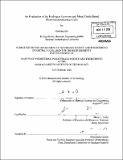| dc.contributor.advisor | Harry L. Tuller. | en_US |
| dc.contributor.author | Zhu, Jianfeng, M. Eng. Massachusetts Institute of Technology | en_US |
| dc.contributor.other | Massachusetts Institute of Technology. Dept. of Materials Science and Engineering. | en_US |
| dc.date.accessioned | 2011-05-09T15:19:28Z | |
| dc.date.available | 2011-05-09T15:19:28Z | |
| dc.date.copyright | 2010 | en_US |
| dc.date.issued | 2010 | en_US |
| dc.identifier.uri | http://hdl.handle.net/1721.1/62684 | |
| dc.description | Thesis (M. Eng.)--Massachusetts Institute of Technology, Dept. of Materials Science and Engineering, 2010. | en_US |
| dc.description | Cataloged from PDF version of thesis. | en_US |
| dc.description | Includes bibliographical references (p. 130-142). | en_US |
| dc.description.abstract | Fossil fuels depletion and climate change are driving the need for sustainable development and renewable energy sources globally [1]. Solar being the most abundant and widespread source of renewable energy is resulting in a rapidly growing, with a growth rate more than 35% annually for the past 10 years [4]. Hydrogen is an ideal energy carrier for next generation given its high efficiency, environmental friendliness, wide application as well as several attractive methods for storage and distribution [17]. The hydrogen economy, a proposed system of producing, delivering and employing energy by using hydrogen, is under intensive research and development, and is projected to be realized at the end of this century as one of the leading suppliers [60]. Photo-electrochemical (PEC) cells connect the solar energy and hydrogen economy together by directly converting solar energy into chemical energy in the form of hydrogen gas. The metal oxide based PEC cell has advantages of low cost, high stability and durability and environmental friendliness [14], a good option for commercialization. With the rapid development of nanotechnology in recent years, novel nano-structured metal oxide PEC cells can have higher efficiency and better performance due to the effects of quantization, large surface areas, improved charge transport, etc. In this thesis, the current status and future development of the hydrogen economy in terms of identifying the markets, opportunities and risks of solar-hydrogen has been reviewed and accessed. The technology review of PEC cells in terms of the working mechanism and efficiency determining factors has been studied. The current research efforts on metal oxide based PEC cells for optimizing the performances and processing methods have also been studied. A case study and cost modeling in the context of scenario has been conducted; the analysis showed the cost of PEC cells was still very high mainly due to the high materials and processing costs. Thus, future research development should focus on the technological approaches with low materials and processing costs and high energy conversion efficiency for earlier commercialization of PEC cells. Besides, hydrogen storage, distribution, safety codes and standards, education and training as well as fuel cell technology must also require intensive research and development to insure the realization of solar-hydrogen economy. | en_US |
| dc.description.statementofresponsibility | by Jianfeng Zhu. | en_US |
| dc.format.extent | 159 p. | en_US |
| dc.language.iso | eng | en_US |
| dc.publisher | Massachusetts Institute of Technology | en_US |
| dc.rights | M.I.T. theses are protected by
copyright. They may be viewed from this source for any purpose, but
reproduction or distribution in any format is prohibited without written
permission. See provided URL for inquiries about permission. | en_US |
| dc.rights.uri | http://dspace.mit.edu/handle/1721.1/7582 | en_US |
| dc.subject | Materials Science and Engineering. | en_US |
| dc.title | An evaluation of the hydrogen economy and metal oxide based photo-electrochemical cells | en_US |
| dc.type | Thesis | en_US |
| dc.description.degree | M.Eng. | en_US |
| dc.contributor.department | Massachusetts Institute of Technology. Department of Materials Science and Engineering | |
| dc.identifier.oclc | 714364751 | en_US |
